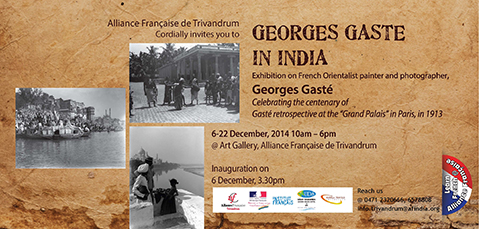Date/Time
Date(s) - 18/12/2014 - 22/12/2014
12:00 am
Location
Alliance Française de Trivandrum
Categories
 GEORGES GASTÉ IN INDIA : 1905-1910: A photo exhibition paying tribute to the people and the magic of India at the turn of the twentieth century from 9 to 22 December at Art Gallery, Alliance Française de Trivandrum.
GEORGES GASTÉ IN INDIA : 1905-1910: A photo exhibition paying tribute to the people and the magic of India at the turn of the twentieth century from 9 to 22 December at Art Gallery, Alliance Française de Trivandrum.
The exhibition will be inaugurated on 5.30pm, 9 December @ Art gallery, Alliance Française de Trivandrum.
Over a century after Georges Gasté’s death in Madurai, the Institut français in India (IFI) offers a new life to the photographic work of this French Orientalist painter. A selection of eight of his pictures was already displayed at the Indira Gandhi International Airport in the frame of Fete de la Photo – a pan-India outdoor photo festival organized at the initiative of the IFI in March-April 2014. Following the success of this initiative, we are now presenting a much broader body of work which will be traveling to 8 Indian cities as a touring photographic exhibition.
The project « GEORGES GASTÉ IN INDIA : 1905-1910 » comprises of 34 remarkable photographs taken by Georges Gasté during his sojourn in India in the first decade of the twentieth century. Along with those will be showcased colour reproductions of his paintings and a few of the letters written by the artist. A documentary film on Gasté’s life will also be screened in the gallery.
Constant-Georges Gasté (Paris, 1869 – Madurai, 1910)
Trained from the highly selective Ecole des Beaux-Arts (School of Fine Arts) in Paris, Gasté was a noteworthy painter of his time. Reputed among the French Orientalist movement, which focused on foreign -especially Nothern African and Middle-Eastern- cultures, he received multiple awards at the Orientalist Salon in his lifetime. Two retrospectives of his work were organized at the Grand Palais after his death, in 1911 and 1913. His most famous canvas, The Brahmins’ Bath, is conserved at the Musée d’Orsay in Paris. Following a trip to Northern India in 1905, he settled down in Madurai in 1908 where he breathed until his last.
In the nineteenth century, while the theme of the journey to the East was most often adopted as a way to excite the fantasies of a few Europeans, artists like Gasté refused to fuel this perception – certainly exotic and fascinating, yet far from reality. In addition to the remarkable composition and lighting effects, his work presents an ethnographic interest: due to the proximity between the painter and local populations, those photos narrate the everyday life in Agra, Benares, Delhi and Madurai at the turning point between two centuries.
